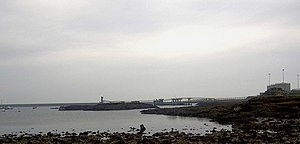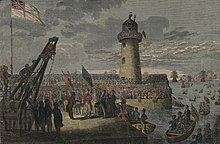


The Port of Holyhead (Welsh: Porthladd Caergybi) is a commercial and ferry port in Anglesey, United Kingdom, handling more than 2 million passengers each year. It covers an area of 240 hectares, and is operated by Stena Line Ports Ltd. The port is the principal link for crossings from north Wales and central and northern England to Ireland. The port is partly on Holy Island and partly on Salt Island (Welsh: Ynys Halen). It is made up of the Inner Harbour, the Outer Harbour and the New Harbour (opened in 1880), all sheltered by the Holyhead Breakwater which, at 2.7 kilometres, is the longest in the UK.
History

Formerly subservient to Beaumaris as the region's main port, Holyhead came into its own in the early 19th century, when Thomas Telford built a new road to connect north Wales with London. The Admiralty Pier was constructed in 1821, and was used by the City of Dublin Steam Packet Company. The so-called "Irish Mail Line" of the Chester & Holyhead Railway ran from Holyhead railway station to the pier. The Admiralty Arch was built in 1824, marking the end of Telford's new road. The arch was designed by Thomas Harrison and its main purpose was to commemorate the visit of King George IV of the United Kingdom in 1821, when he arrived in Holyhead on the royal yacht, before leaving on a state visit to Ireland on the steam packet Lightning.
In 1845, an Act of Parliament led to the construction of the new port, and a new railway station was opened in 1851. In 1853, Queen Victoria of the United Kingdom arrived in the port of Holyhead with the royal party, including her consort Prince Albert and two of her sons, including the young Prince of Wales. The breakwater was completed in 1873, and was declared open by the same Prince of Wales, now an adult, who officially opened the New Harbour on 17 June 1880. A new station hotel was erected at about the same time. However, as a starting point for sea journeys to Ireland, Holyhead soon had a rival, as the port of Fishguard began operating ferries in 1906.
In 1916, a naval base was created and the Irish Sea Hunting Flotilla was established later in the First World War to combat U-boats operating in the Irish Sea. During the 1930s, a trade war with the newly established Republic of Ireland had an adverse effect on the level of use of the port, which caused widespread unemployment in the town of Holyhead. During the Second World War, however, the Royal Dutch Navy began using the port as a base. In June 1939, the Royal Navy submarine HMS Thetis sank during sea trials in Liverpool Bay, and it was subsequently brought to the harbour at Holyhead after being beached at Traeth Bychan. It remained at Holyhead in dry dock while the contents were removed; fourteen of the 99 victims were buried locally. A new container port opened at Holyhead in 1970, the container service between Holyhead and Dublin having begun two years earlier. Major changes were made to the port facilities, and the station hotel was demolished in 1978. Bigger ferry vessels came into use, and the Stena Lynx 1 catamaran began services in the early 1990s.
In the late 20th century, the port was owned by Sealink (later Stena Sealink), a ferry company which ran a fast ferry from the Admiralty Pier and slower ferries from an alternative berth. The Irish ferry company B&I also operated ferries to and from Ireland from the port of Holyhead. B&I took Sealink to court in 1992 for imposing less favourable conditions on its competitor when using the port. In the following year, another company, Sea Containers Ltd, took legal action against Sealink Ports on similar grounds. Stena Line discontinued its fast ferry service in 2015, leaving Irish Ferries operating the fastest service between Holyhead and Dublin.
In December 2024 port infrastructure was damaged by Storm Darragh and rendered unusable, causing disruption to traffic between Britain and Ireland. It is not expected to function again until at least mid-January 2025.
Current services

Stena Line and Irish Ferries sail from Holyhead to Dublin in Ireland. There is access to the port via a building shared with Holyhead railway station, which is served by the North Wales Coast Line to Chester and London Euston. The walk between trains and ferry check in is less than two minutes, but longer from the remote platform 1, used by Avanti West Coast services. The port is accessible to motor vehicles via both the A5 and the A55 roads. Pedestrian access from Holyhead town centre is via the Celtic Gateway, a bridge linking town and port, and takes about five minutes. The largest ferries arrive and depart from the 300-metre Admiralty Pier.
References
Notes
- "Sea Passenger Statistics 2007". 29 May 2008. Archived from the original on 22 November 2008. Retrieved 14 December 2008.
- ^ "Holyhead". Ports and Harbours of the UK. Retrieved 26 April 2016.
- ^ Phil Carradice. "The opening of Holyhead's new harbour". BBC Blogs - Wales. Retrieved 26 April 2016.
- John Maxwell Dunn (1948). The Chester & Holyhead Railway. Oakwood Press.
- ^ Geraint Jones; Gwenllian Jones Rowlinson (6 July 2015). Anglesey Towns and Villages. Amberley Publishing Limited. pp. 55–. ISBN 978-1-4456-5153-8.
- Deborah Fisher (2010). European Royal Wales. University of Wales Press. p. 7. ISBN 978-0-7083-2214-7.
- Joseph Hone (7 July 1953). "Queen Victoria in Ireland, 1853". History Today: Archive. Retrieved 26 April 2016.
- Cragg, Roger (1997). Civil Engineering Heritage Series: Wales & West Central England. Thomas Telford. pp. 7–8. ISBN 0727725769.
- ^ Ann Roberts. "Brief History of the Holyhead Port". www.holyhead.com/holyheadporthistory. Archived from the original on 10 September 2011. Retrieved 26 April 2016.
- E. van Hooydonk (1 January 2003). European Seaports Law: The Regime of Ports and Port Services Under European Law and the Ports Package. Maklu. pp. 43–. ISBN 978-90-6215-804-1.
- Owen Hughes (4 February 2015). "Stena Line fast ferry service from Holyhead to Ireland scrapped after passenger numbers fall by 90%". WalesOnline. Retrieved 26 April 2016.
- "Dublin Swift". Irish Ferries. Retrieved 26 April 2016.
- Boland, Lauren (12 December 2024). "Holyhead port remains closed as around 150,000 parcels backlogged at the port". Retrieved 13 December 2024.
- "Holyhead Port to stay closed until 15 January 'at the earliest'". RTÉ News. 17 December 2024. Retrieved 17 December 2024.
Bibliography
- Cowsill, Miles; Hendy, John (1996). Holyhead-Dun Laoghaire: From Car Ferry to HSS 1965–1996. Narberth, Pembrokeshire: Ferry Publications. ISBN 1871947383.
- Merrigan, Justin (2016). Dun Laoghaire Holyhead 1826–2015: The rise and decline of Ireland's premier route. Ramsey, Isle of Man: Ferry Publications. ISBN 9781906608828.
External links
53°18′34″N 4°37′44″W / 53.3094°N 4.6289°W / 53.3094; -4.6289
| Ferries of the Irish Sea | |||||||||||||
|---|---|---|---|---|---|---|---|---|---|---|---|---|---|
| Current ships |
| ||||||||||||
| Ferry ports | |||||||||||||
| Harbours of the UK and Crown Dependencies | |
|---|---|
| England | |
| Wales | |
| Scotland | |
| Northern Ireland | |
| Crown Dependencies | |